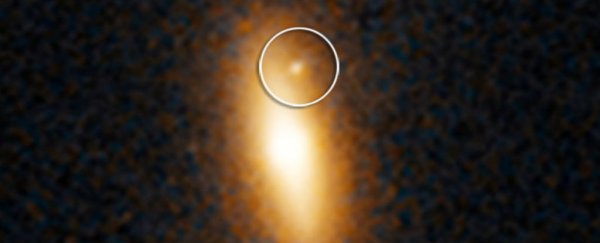Supermassive black holes are thought to sit at the centre of every galaxy in the Universe. It's not clear why they're always in the middle, but we're safe in the knowledge that those devastating whirlpools of nothingness stay where they're supposed to… until they don't.
A newly discovered black hole appears to have been knocked from its perch by another galaxy, and is now tearing - unanchored - through its own galaxy. Let's all just take a moment to appreciate the very well-behaved black hole at the centre of the Milky Way, shall we?
Regular black holes form when a star at least five times more massive than the Sun runs out of fuel, and collapses in on itself to create a destructive void that not even light can escape.
There are also massive black holes - sometimes referred to as intermediate-mass black holes - which are 100 to 100,000 times more massive than our Sun.
Supermassive black holes, on the other hand, contain hundreds of millions of times the mass of our Sun. The biggest ones can even be as heavy as 10 billion Suns.
Massive and supermassive black holes are thought to be at the heart of every galaxy in the Universe.
This looming presence is intrinsic to the existence of a galaxy - they even grow in tandem with each other - but no one's entirely sure why these black holes always end up at the centre.
One hypothesis is that the black hole existed first, and managed to pull an entire galaxy full of stuff in around it.
Another suggestion is that the dark matter halo that surrounds every galaxy concentrates new galaxy material in such a way that you end up with a massive or supermassive black hole in the centre, and stars everywhere else.
Regardless of how they got there, supermassive black holes tend to stay put in the centre of a galaxy - but physicists have hypothesised that on very rare occasions, something catastrophic can knock them free.
Now it looks like we've found one such 'wandering' supermassive black hole, tearing through the edges of galaxy SDSS J141711.07+522540.8, some 4.5 billion light-years from Earth.
We've known about this massive object, called XJ1417+52, for over a decade now, and previous estimates have placed its mass at around 100,000 times that of our Sun. But back when we first spotted it, it appeared to still be anchored to its galactic centre.
The team that spotted it, led by physicist Dacheng Lin from the University of New Hampshire, suggests that the black hole broke free when its galaxy merged or collided with a neighbouring galaxy - something that's expected to happen to the Milky Way in 5 billion years or so.
It's thought that when this collision happened, a sun from one galaxy wandered too close to the supermassive black hole of the other one, and the black hole got dislodged, and the sun shredded.
That explains why when the team observed the black hole for the first time between 2000 and 2002, it looked so incredibly bright. Only in the past few years did they manage to locate the source of this flash.
As George Dvorsky explains for Gizmodo, the gaseous debris produced by this encounter generated a tremendous amount of X-rays, that have since been picked up by NASA's Chandra X-ray Observatory and the ESA's XMM-Newton X-ray observatory.
To give you an idea of how bright the encounter was, it was 10 times brighter than the brightest X-ray source ever seen for a potential wandering black hole, and it's also about 10 times further away from us than the previous record holder.
So… should we be worried about a rogue black hole that's doing what it wants, where it wants?
Well, unless we somehow figure out how to travel to places billions of light-years away, the answer is no. But spare a thought for whatever matter it runs into in its own galaxy, because death by black hole is no fun for anyone.
The discovery has been accepted for publication in the Astrophysical Journal, but you can read it at pre-print website, arXiv.org.
